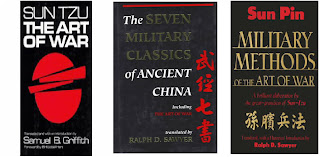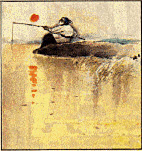For the newbies arriving here the first time, this article establishes the premise of how the Collaboration360 "team collaborative methodology" originated
Read and enjoy.
# # #
Learning from the Chinese Strategic Classics
By M.H.

When people hear the book title Sun Zi's Art of War, they think of a well-known Chinese treatise on strategy and tactics and its famous passages like "One who knows the enemy and knows himself will not be endangered in a hundred engagements."
To its serious followers, the value of this book is "its emphasis on the world's view… the necessity of acquiring intelligence and consequent need to employ spies; evaluating opponents; manipulating enemies; being formless and unknowable; creating and employing strategic power; qi or spirit; the unorthodox and orthodox; leadership and command; configurations of terrain; thwarting the enemy's plans and balking his alliances; and achieving victory as economically as possible, preferably without costly combat." ( http://ralphsawyer.com/work1.htm.)
Some of those qualities can be found in other Chinese strategic classics like Jiang Tai Gong's Six Secret Teachings and Wu Zi Art of War.
This book is credited with "…influencing Napoleon, the German general staff, and the planning of Operation Desert Storm. Leaders as diverse as Mao Zedong, Vo Nguyen Giap, and General Douglas MacArthur have claimed to have drawn inspiration from the work. Since the late 20th century, The Art of War has also been applied, with much success, to business and managerial strategies." ( http://en.wikipedia.org/wiki/The_Art_of_War.)
The following article is about this writer's journey of creating a strategic process to meet the needs of Global 2000 companies through his interest in the ancient Chinese strategy classics.
The Beginning
My interest in strategy started in high school with the reading of Miyamoto Musashi's classic The Book of Five Rings, then General Samuel B. Griffith's translation of Sun Zi The Art of War (Pinyin transliteration) [Sun Zi is often known as Sun Tzu as the spelling of Sun Tzu was based on the Wales-Giles system] and Machiavelli's The Prince. Presume a "tactical response/fortune cookie-like proverb" viewpoint as the essence of the Chinese Strategy mindset. (See below for a list of recommended resources.)
Years later I discovered other Chinese strategy classics and more translations of Sun Zi's essay. I realized how incomplete my perspective was in terms of not having a big picture that enables strategic leadership and anticipation. I then decided to enlarge my understanding of the Chinese strategy mindset by reading everything on Chinese strategy, Chinese military history, and Daoism. Later I acquired experience by applying those concepts learned from the classics to various competitive business situations.
Discovering the Challenge
In late 2002, my team and I were in search of a new niche to compete in the global marketplace. We noticed that there was a great need for better collaboration between people located in remote sites. From our own personal experience and research, we agreed that the current solution of using technology as a collaborative tool is not effective in terms of getting people to collaborate, and that quick technological access to people did not mean effective collaboration was occurring. We decided to develop a strategic solution that redefines "collaboration" based on the following definition: "… collaboration is unified teamwork that exceeds all barriers of distance, technology, and culture…"
At that moment, our quest to meet the challenge of defining "collaboration" began.
Starting Stage (1): Define the Goal
The initial product development began with my own yearly tradition of re-reading the Chinese strategy classics and various global history books where I was reminded of the importance of developing a complete mission that supporters can understand and connect with. From that perspective, we developed the following dictum: "If the team collaboratively defines and unifies with a mission goal and its specifics, they will collaboratively complete it."
Generally, that point is nothing new. The challenge was knowing how to do it. From personal experience and research, we discovered that most people did not know how to develop a complete mission definition that their supporters could understand. That became the first part of our goal.
While developing the process of defining a complete mission definition, we came up with the next challenge: "… can a project team collaboratively stay unified under its mission vision despite their separation by distance, project culture, and possibly technology?…"
After months of researching and prototyping, we developed a methodology that completed those two objectives. It was based on the following point: "… A team that collaboratively defines and unifies with their big picture (with proper specifics), will collaboratively implement it as a team regardless of distance, technology, and project culture…"
Starting Stage (2): Connect to the Classics
As mentioned before, the concept of defining and understanding the big picture was inspired from my understanding of the various Chinese military classics and famous Chinese military thinkers. Much of its foundation was influenced by the concepts found in the eight military classics of ancient China (my description of combining the Seven Military Classics of Ancient China and Sun Bin's Military Methods as one set). From the Seven Classics, we learned the following topics: simple tactical principles through complex methods of organization, command and control, campaigning, psychological operations and disinformation, maneuver, strategic power, intelligence, manipulating the enemy, deception, regulation and constraint, evaluating the enemy, mustering martial qi, and the nature of warfare. In the case of Sun Pin's Military Methods (Sun Bin's Art of War) we achieved insightful understanding on maneuvering warfare, the use of qi, command and character, strategic power, and unorthodox warfare.
Our other role models were Zhang Liang (a strategic advisor to the Han Dynasty emperor who was famous for developing situational-winning strategies from a remote location and his collaborative actions to gain the trust of people around him). We spent many months researching and hypothesizing on the fundamentals behind Zhang Liang's approach to strategy and collaboration and then developed a conceptual outline based on our perception.
The next step was using this conceptual outline to build the foundation of our remote project collaboration methodology. The goal of our new system was to enable people located at different remote sites to collaborate as a team regardless of the distance, technology, and project culture. We believe that a remote team for a Global 2000 company that collaborates with our system possesses a competitive advantage over their competition. At this junction, our global collaborative solution is on the verge to being launched.
Conclusion
There are no superior translations of Sun Zi's essay or "brain-busting" strategy treatises that would make you the super strategist that you dream to be. It's all about superior people who define and execute their plan based on their consummate understanding of strategic and tactical principles and their own settings.
I believe that many things can be derived from the reading of these strategy classics. It starts by understanding the fundamentals of what your interest is about, then knowing what to focus on in terms of the big picture. The final step is connecting the strategy principles with your current endeavor.
The following is an abridged listing of those books that this writer used in his research:
* Ralph D. Sawyer translations of the Chinese classics (Seven Military Classics;
* Sun Zi Art of War;
* Sun Bin (Sun Pin) Military Methods,
* 100 Unorthodox Strategies, etc.);
* Roger D. Ames translation of Sun Zi and Sun Bin's Art of Warfare,
* Mark McNeilly's Sun Tzu and The Art of Business and Sun Tzu and The Art of Warfare;
* John T. Minford's rendition of the Art of War; and
* 36 Stratagems Applied to Go.
M.H. is a chief founder of a global team collaborative strategic consulting and training startup and a project management strategist. Please send any questions or comments to 360.yahoo.com/c360chiefarchitect |
The original article was published at JadeDragon.com on Oct 2006.
Copyright: 2006-2007 © Collaboration360 Consultants
Any questions, please contact us at service [aat ]collaboration360 [dott].com
Replace [aat] with @ and [dot] with .





